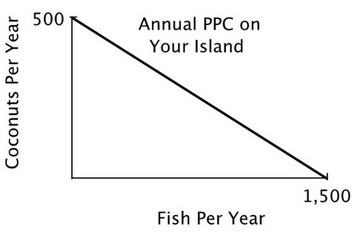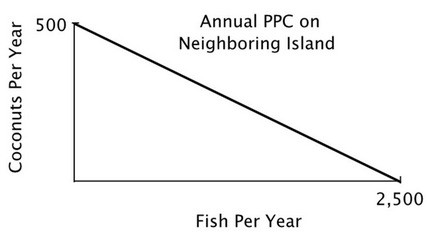You are the Minister of Trade for a small island country with the following annual PPC: You are negotiating a trade agreement with a neighboring island with the following annual PPC:
You are negotiating a trade agreement with a neighboring island with the following annual PPC:  Both islands specialize exclusively in the product for which they have a comparative advantage. You have agreed to give 350 coconuts to the other island in exchange for 1,300 fish. After the trade, your island has a total of ________ coconuts and ________ fish.
Both islands specialize exclusively in the product for which they have a comparative advantage. You have agreed to give 350 coconuts to the other island in exchange for 1,300 fish. After the trade, your island has a total of ________ coconuts and ________ fish.
A. 150; 2,800
B. 500; 1,500
C. 500; 1,300
D. 150; 1,300
Answer: D
You might also like to view...
Refer to Table 19-8. Suppose that a simple economy produces only four goods and services: sweaters, CDs, sugar, and soft drinks
Assume one half of the sugar is used in making the soft drinks and the other half of the sugar is purchased by households. Calculate nominal GDP for this simple economy.
Suppose that Canada can produce 15 units of timber or 3 units of grain. Suppose that Mexico can produce 6 units of timber or 2 units of grain. Which of the following is CORRECT?
A) Mexico has a comparative advantage in grain production. B) Mexico has an absolute advantage in timber production. C) Canada has a comparative advantage in grain production. D) The countries would find trade mutually beneficial at a trading ratio of 1 grain for 2 timber.
Some researchers argue that the American Revolution was probably inevitable. The most important factor, of those listed below, was/were
(a) prohibitions against trade with nations other than England and severe exploitation of the colonists under the Navigation Acts, which kept the standard of living low in the colonies. (b) excessive taxation which for generations kept the after-tax incomes of the colonists below those in England. (c) a series of revenue-raising measures imposed on the colonists at the end of the French and Indian War for the purpose of making the colonies more self-supporting. (d) British prohibitions against the use of slaves in the lands west of the original thirteen colonies.
Considering the concept of cross-price elasticity, if two goods are complements:
A. an increase in the price of one will cause a decrease in the demand for the other. B. an increase in the price of one will cause an increase in the demand for the other. C. a decrease in the price of one will cause a decrease in the demand for the other. D. the cross-price elasticity is positive.